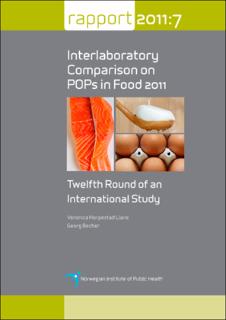| dc.description.abstract | In 2011, the twelfth round of the Interlaboratory Comparison on POPs in Food was conducted on the determination of the 2,3,7,8-chlorinated dibenzo-p-dioxins (PCDDs) and dibenzofurans (PCDFs) as well as dioxinlike non-ortho and mono-ortho chlorinated biphenyls (dl-PCBs) in three different food items. In addition laboratories could voluntarily determine and report six Indicator PCBs, polybrominated diphenyl ethers (PBDEs) and hexabromocyclododecane (HBCD). The objectives of this interlaboratory comparison study were a) to offer a quality assurance instrument for the participating laboratories, b) to assess the between laboratory reproducibility and c) to assess the readiness of expert laboratories world-wide to determine levels of chlorinated and brominated persistent organic pollutants in regular foodstuffs.
The 2011 study was performed on sample homogenates of salmon filet, mozzarella cheese and eggs. In addition, six standard solutions were provided containing known concentrations of 1) PCDDs/ PCDFs, 2) nonortho PCBs, 3) mono-ortho PCBs, 4) PBDEs, 5) Indicator PCBs and 6) α-HBCD. The testing materials were sent to 103 laboratories in January 2011, and results were returned from 101 laboratories in 31 different countries by the deadline in April. Most laboratories analyzed all the three food items. A draft report was made available on the Internet in August and was discussed among the participants at the Waters New Technology Forum during the DIOXIN 2011 Symposium in Brussels, Belgium.
This report presents the submitted results for: all seventeen 2,3,7,8-substituted PCDDs/PCDFs, the nonortho substituted PCBs #77, 81, 126 and 169 and the eight mono-ortho substituted PCBs #105, 114, 118, 123, 156, 157, 167, 189 in the three food items on a fresh weight and lipid weight basis. In addition, the results for eight PBDEs #28, 47, 99, 100, 153, 154, 183 and 209, six Indicator PCBs #28, 52, 101, 138, 153 and 180, and total HBCD as well as the α-, β- and γ-isomers were reported from those laboratories that voluntarily determined their concentrations. Non-detected congeners were assigned a concentration corresponding to the reported detection limit except for PBDEs, Indicator PCBs and HBCD where non-detects were removed from the data set. The consensus concentration (assigned value) for each analyte in the three food samples was determined as follows: The median of all reported concentrations for each analyte was calculated. All values above two times the median were removed from the calculation. The consensus median and consensus mean plus standard deviation (SD) were calculated from the remaining data. Toxic equivalents (TEQs) were calculated from the consensus values of individual congeners using the toxic equivalency factors derived by WHO in 1998 and 2005. Z-scores for PCDD/PCDF TEQs were calculated for each laboratory using ± 20% of the consensus TEQs (WHO1998TEQs) as a value for target standard deviation (σ). Further, Z-scores were calculated for the non-ortho PCB TEQ, the mono-ortho PCB TEQ, the total TEQ, the sum of six Indicator PCBs, the sum of eight PBDEs, total HBCD, and the three isomers of HBCD and for each single congener in all three matrices.
The consensus values for the standard solutions were calculated as mentioned above except that values outside ± 50% of the median of all values were removed prior to the final calculation of the consensus median and mean. The consensus values for the lipid content were calculated by first excluding results deviating more than two SD from the mean of all values and then recalculating the median, mean and SD.
For the determination of total TEQs in the three food samples, Z-scores within ± 1 were obtained by 76- 85% of the laboratories. The majority of the laboratories (88-90%) reported results for total TEQ with a trueness of ± 40% for all food samples (Z-score ± 2). The relative standard deviation (RSD) calculated for the total TEQ after removal of outliers was 11-13%. It is therefore concluded that the performance of laboratories world-wide in determining dioxin-like compounds is generally good for the food samples included in this study.
For the different food samples, between 55-68 laboratories reported results for the six Indicator PCBs, 31-41 laboratories reported concentrations for the seven tetra- to hepta-BDEs and 22-27 laboratories reported concentrations for BDE-209. The concentrations of the sum of seven PBDEs on fresh weight basis were 2130 (28%), 220 (33%) and 258 (31%) pg/g in salmon, Mozzarella and eggs, respectively, with average RSD given in parentheses. The consensus concentrations for BDE-209 were 42 (n=27), 28 (n=25) and 111 (n=22) pg/g fresh weight in salmon filet, Mozzarella cheese and eggs, respectively. The corresponding RSD on fresh weight basis were 48, 62 and 36%. The consensus concentrations calculated for HBCD are just indicative values as only few laboratories reported results. The sums of concentrations on fresh weight basis for six Indicator PCBs were 32.3 ng/g (26%) in salmon, 0.92 (37%) ng/g in Mozzarella cheese and 1.45 (33%) ng/g in eggs. Average RSDs are given in parentheses. | |
